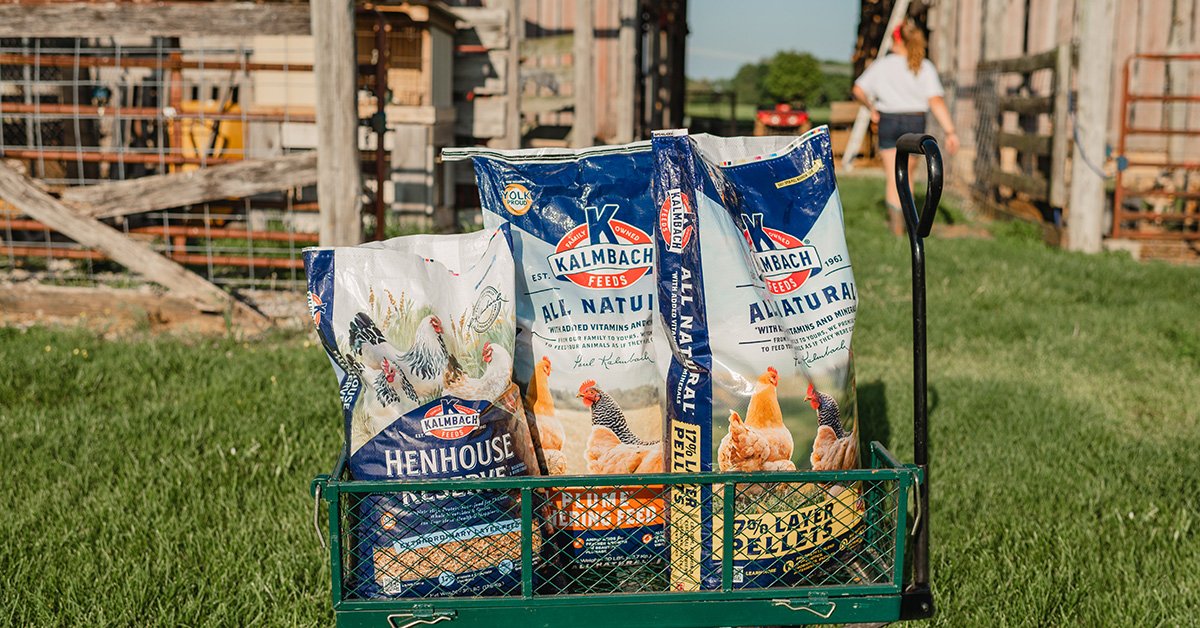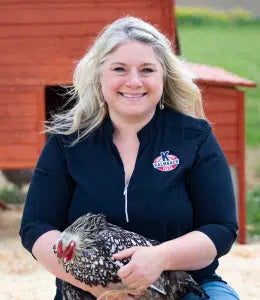Protein – Can You Have Too Much of a Good Thing?

Fall is molting season for poultry, and it is very common to hear a lot of discussion about protein in poultry diets while our chickens are molting. Today, we are going to talk about protein, how much protein chickens actually need, and then discuss what happens if we give too much of a good thing.
What Is Protein?
Protein is arguably our most recognizable nutrient in livestock feeds. In fact, protein is so well-known that we often include the amount of protein right in the name of our products – 17% Layer or 20% Full Plume Feathering Feed.
Protein is also one of the six basic classes of nutrients (1. carbohydrates; 2. PROTEIN, 3. fat, 4. vitamins, 5. minerals, and 6. water) that all living creatures need to stay healthy and strong. Proteins are complex molecules made of building blocks called amino acids. So, what makes a protein a protein? Nitrogen bonds! Nitrogen and how those bonds are excreted and broken down are really important factors to consider when evaluating the amount of protein that you feed to your chickens.
How Much Protein Do Chickens Need?
This is a common question and, unfortunately, there is no one-size-fits-all answer. Generally, most adult mature chickens need between 16-20% protein, but that number can vary depending on breed, environmental conditions, and your goals for your flock. There are certain circumstances where the protein requirement may be slightly higher – like during a molt or when feed intake is limited – but most mature adult poultry do not need large amounts of protein on a day-to-day basis.
Molting season is definitely the time when most poultry keepers become concerned about the amount of protein their birds are getting. New feathers are formed right under the skin in the follicles and once completely formed, can be over 90% protein in the form of keratin. Feather growth also uses a lot of sulfur-containing amino acids, like methionine and cysteine. Remember, amino acids are the individual building blocks of protein, and each amino acid is different. Methionine and cysteine are unique because they contain sulfur bonds and bridges which help the feathers remain rigid.
Given that feathers are primarily protein, it’s natural to wonder if you should feed more protein during the molt. Yes, you can increase protein during the molt, but don’t overdo it! Most adult mature poultry do not need more than 20% crude protein even during a molt. Molting does not usually happen all at once, so the need for more protein is spread out over a few weeks. Most birds will begin losing feathers on the neck, then back, and then breast and thighs. In fact, you may not even notice the molt until you see feathers on the floor of your coop or start to see new feathers begin to poke through on your birds. Feeding very-high-protein feeds, like cat food or large volumes of meal worms, will increase protein, but probably by too much!
What Happens If We Give Too Much of a Good Thing?
If a bird eats too much protein, that excess protein has to be broken down by the kidneys and excreted. In humans, we excrete excess nitrogen via urine. Chickens don’t urinate, so they excrete excess nitrogen in uric acid – the white stuff on the poop. Uric acid contains nitrogen and nitrogen breaks down to ammonia gas. Ammonia gas becomes important because it stinks! If you have ever been in a chicken coop that smells really bad and makes your eyes water, there is a good chance that coop has high levels of ammonia gas from over-feeding protein.
If a bird eats too much protein from time-to-time, it’s usually nothing to worry about. A meal worm treat is just fine and usually quite welcomed by your birds! Chickens are great self-regulators and their digestive tracts can handle small changes in nutrient intake quite well. However, if a bird is fed far too much protein for extended periods of time (i.e., months), then the stress of continuously digesting and excreting that excess nitrogen can have deleterious effects on the kidney function of that bird. In some cases, renal failure can occur.
So, should you change feeds during the molt? If you want to give your birds some extra nutrition to help them during the molt, there are great feed options available. Stick to products that are well balanced and formulated specifically for poultry, like Full Plume Feathering Feed. Extra treats, like mealworms, fish, or other common high-protein foods can be used, but should only be given at about 10% of total feed intake. You want your complete feed to be the bird’s main source of nutrition.
Keeping poultry is such a wonderful experience and the rewards are many! At Kalmbach Feeds, we are always here to help. If you have any questions about the nutrient needs of your birds, feed options, or general poultry keeping, please let us know. We are so excited to continue writing about all of the topics that are important to you and can’t wait to continue learning about your flocks. Stay tuned and thank you for choosing Kalmbach Feeds!
